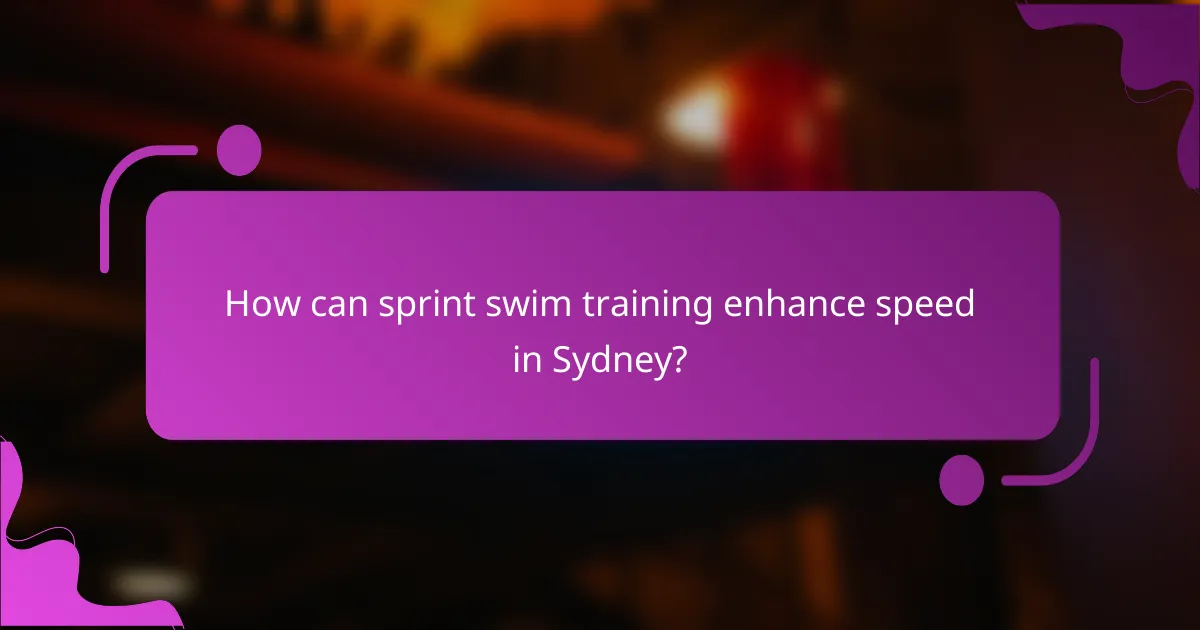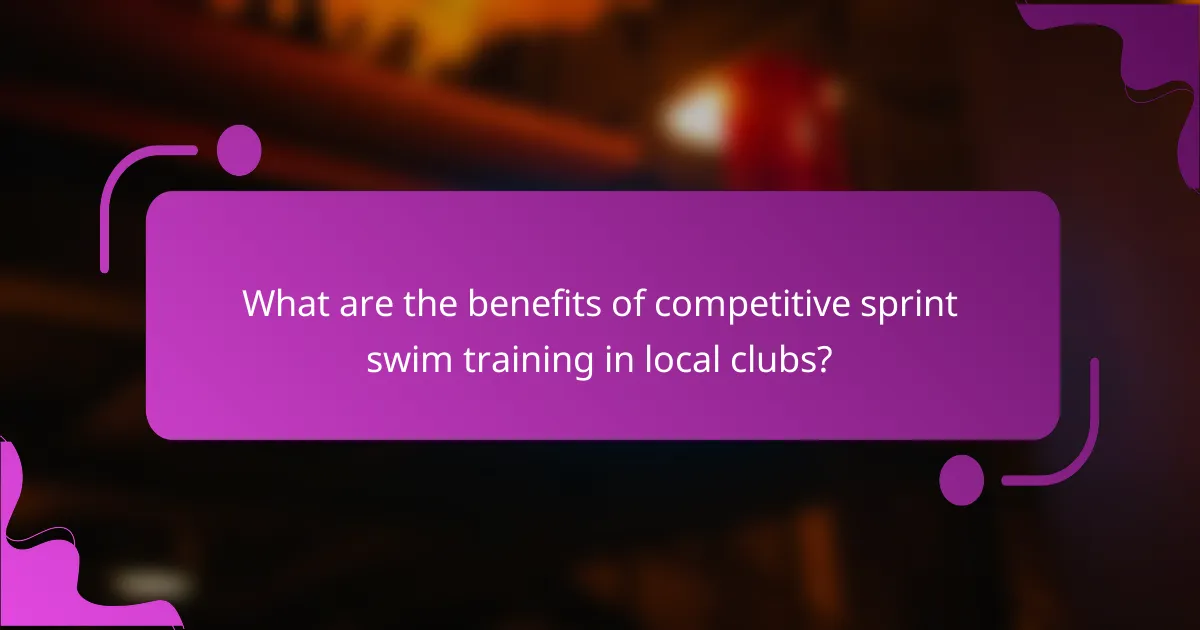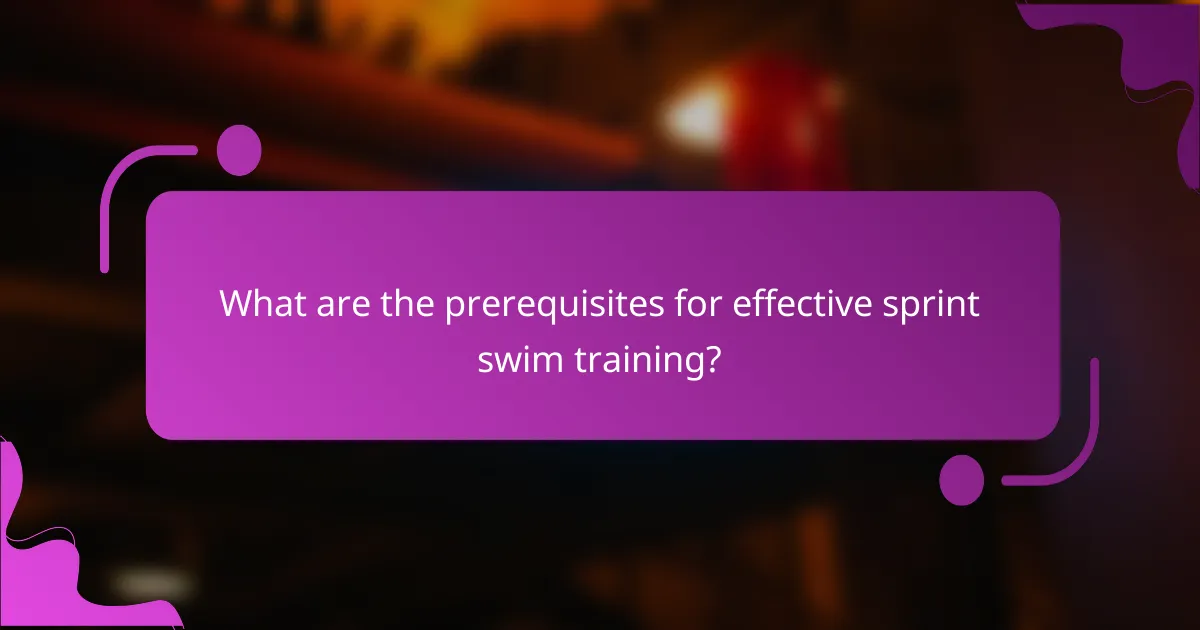Sprint swim training is crucial for enhancing speed and improving technique, ultimately leading to better competitive performance. By focusing on tailored workouts, interval training, and mastering essential skills like starts and turns, swimmers can significantly elevate their capabilities in the pool. Access to specialized coaching and a supportive team environment further amplifies these outcomes, making competitive success more attainable.

How can sprint swim training enhance speed in Sydney?
Sprint swim training can significantly enhance speed by focusing on technique, power, and efficiency. In Sydney, swimmers can benefit from tailored workouts that improve their overall performance in competitive environments.
Improved stroke efficiency
Improving stroke efficiency is crucial for enhancing speed in sprint swimming. Swimmers should focus on minimizing drag and maximizing propulsion through streamlined body positions and effective arm movements. Techniques such as high elbow recovery and proper hand entry can lead to smoother strokes.
Practicing drills like catch-up freestyle or single-arm swimming can help swimmers refine their stroke mechanics. Regular video analysis can also provide insights into areas for improvement, allowing for targeted adjustments.
Increased power output
Increasing power output directly contributes to faster swim times. Swimmers can achieve this through strength training and explosive movements in the water, such as sprint intervals and resistance training with tools like paddles or fins. These methods build muscle strength and enhance overall power.
Incorporating dryland exercises, such as squats and plyometrics, can further boost explosive power. Athletes should aim for a balanced routine that combines both in-water and out-of-water training to maximize their power output.
Optimized breathing techniques
Optimizing breathing techniques is essential for maintaining speed during sprints. Swimmers should practice bilateral breathing to ensure a balanced stroke and improve oxygen intake. This technique allows for better body rotation and helps maintain speed without excessive fatigue.
Drills that focus on breath control, such as breathing every three strokes, can enhance lung capacity and efficiency. Swimmers should also be mindful of their breathing rhythm during sprints, ensuring they are not disrupting their stroke pattern.

What techniques improve sprint swimming performance in Australia?
To enhance sprint swimming performance in Australia, swimmers should focus on interval training, mastering starts and turns, and practicing drills for optimal body position. These techniques are essential for developing speed, improving technique, and achieving competitive performance in the pool.
Interval training methods
Interval training involves alternating periods of high-intensity swimming with rest or lower-intensity swimming. This method helps build speed and endurance, crucial for sprint events. Swimmers can incorporate sets of 25 to 50 meters at maximum effort, followed by short rest intervals of 15 to 30 seconds.
For effective interval training, swimmers should aim for a mix of distances and paces. For instance, a typical session might include several 50-meter sprints followed by longer swims at a moderate pace. This variety helps improve both anaerobic and aerobic capacities.
Starts and turns practice
Practicing starts and turns is vital for sprint swimming, as these elements can significantly impact overall race times. A strong start can save valuable seconds, while efficient turns help maintain speed. Swimmers should focus on explosive starts from the block and smooth, quick turns to minimize time spent at the wall.
To refine these skills, swimmers can dedicate specific training sessions to practicing starts and turns. Drills such as explosive block starts and flip turns with minimal glide can enhance performance. Regular feedback from coaches can also help identify areas for improvement.
Drills for body position
Maintaining an optimal body position is crucial for reducing drag and maximizing speed in sprint swimming. Drills that emphasize body alignment, such as the streamlined position and single-arm swims, can help swimmers develop better technique. A horizontal body position minimizes resistance, allowing for faster movement through the water.
Swimmers should incorporate drills like the catch-up drill and sculling to enhance their feel for the water and improve their body position. Practicing these drills regularly can lead to significant improvements in stroke efficiency and speed during sprints.

What are the benefits of competitive sprint swim training in local clubs?
Competitive sprint swim training in local clubs offers significant advantages, including enhanced speed, improved technique, and better overall performance in competitions. These benefits stem from access to specialized coaching, structured training regimens, and a supportive team environment.
Access to expert coaching
Local clubs often provide access to experienced coaches who specialize in sprint swimming. These coaches can offer personalized feedback, helping swimmers refine their techniques and strategies for races.
Working with experts allows athletes to learn advanced skills, such as starts, turns, and finishes, which are crucial for competitive success. Coaches can also help identify individual strengths and weaknesses, tailoring training to maximize performance.
Structured training programs
Structured training programs in local clubs are designed to progressively build speed and endurance. These programs typically include a mix of drills, interval training, and endurance sets, ensuring a comprehensive approach to sprint swimming.
Swimmers can expect to follow a schedule that balances intensity and recovery, which is essential for improving performance. For example, a typical week might include 3-5 training sessions, each focusing on different aspects of sprinting, such as technique on one day and speed work on another.
Team support and motivation
Being part of a local swim club fosters a sense of community and camaraderie among athletes. Team support can significantly enhance motivation, as swimmers encourage each other to push their limits and achieve personal bests.
Additionally, training alongside peers allows swimmers to share tips and experiences, creating a collaborative learning environment. This team dynamic can be particularly beneficial during competitions, where the support from teammates can boost confidence and performance under pressure.

What factors influence competitive performance in sprint swimming?
Competitive performance in sprint swimming is influenced by a combination of physical conditioning, mental preparation, and nutritional strategies. Each of these factors plays a crucial role in enhancing speed, improving technique, and achieving optimal results in competitions.
Physical conditioning
Physical conditioning is essential for sprint swimmers, as it directly impacts speed and endurance. Training regimens typically include a mix of strength training, cardiovascular workouts, and specific swim drills to build muscle and improve technique.
Swimmers should focus on exercises that enhance explosive power, such as plyometrics and resistance training. Incorporating interval training in the pool can also help improve sprinting speed and overall performance.
Mental preparation
Mental preparation is critical for achieving peak performance in competitive swimming. Techniques such as visualization, goal setting, and mindfulness can help swimmers manage anxiety and maintain focus during races.
Swimmers should practice mental rehearsal by visualizing their race strategy and execution. Developing a pre-race routine can also help establish a sense of calm and readiness before competition.
Nutritional strategies
Proper nutrition is vital for sprint swimmers to fuel their training and recovery. A balanced diet rich in carbohydrates, proteins, and healthy fats supports energy levels and muscle repair.
Swimmers should aim for meals that include whole grains, lean proteins, and plenty of fruits and vegetables. Staying hydrated is equally important, especially before and after training sessions and competitions.

How do local swim clubs measure training outcomes in Sydney?
Local swim clubs in Sydney measure training outcomes through a combination of performance metrics, regular time trials, and feedback from coaches. These methods provide a comprehensive view of a swimmer’s progress in speed, technique, and overall competitive performance.
Performance metrics tracking
Performance metrics tracking involves collecting data on various aspects of a swimmer’s training, such as lap times, stroke efficiency, and heart rate. Clubs often use technology like timing systems and wearable devices to gather this information, allowing for precise analysis of improvements over time.
For instance, a swimmer’s average lap time can be compared against previous sessions to identify trends in speed. Coaches may also assess stroke count and distance per stroke to evaluate technique, ensuring that swimmers are not only faster but also more efficient in the water.
Regular time trials
Regular time trials are scheduled assessments where swimmers compete against the clock to gauge their speed and endurance. These trials typically occur every few weeks and help swimmers set benchmarks for their performance.
During a time trial, swimmers swim a predetermined distance, often 50m, 100m, or 200m, and their times are recorded. This practice not only motivates swimmers to improve but also provides concrete data for coaches to tailor training plans effectively.
Feedback from coaches
Feedback from coaches is crucial for understanding a swimmer’s strengths and areas for improvement. Coaches observe swimmers during training and competitions, providing insights on technique, pacing, and race strategies.
Regular one-on-one sessions can help swimmers refine their skills based on specific observations. For example, a coach might suggest adjustments to a swimmer’s breathing technique or stroke mechanics, which can lead to significant improvements in performance over time.

What are the prerequisites for effective sprint swim training?
Effective sprint swim training requires a solid foundation of basic swimming skills, a good level of physical fitness, and a strong commitment to a training schedule. These prerequisites ensure that swimmers can maximize their performance and achieve their competitive goals.
Basic swimming skills
Before engaging in sprint swim training, swimmers must possess essential swimming skills, including proper stroke technique, breathing control, and body positioning. Mastery of these skills allows for efficient movement through the water, which is crucial for sprinting.
Swimmers should be comfortable with various strokes, particularly freestyle, as it is often the primary focus in sprint training. Regular practice and feedback from coaches can help refine these techniques and build confidence in the water.
Physical fitness level
A good physical fitness level is vital for effective sprint swim training. Swimmers should focus on building strength, endurance, and flexibility to support their sprinting efforts. This can include dryland exercises such as weight training, core workouts, and cardiovascular activities.
Swimmers should aim for a balanced fitness routine that enhances their explosive power and speed in the pool. Engaging in interval training and high-intensity workouts can also help improve overall performance during sprints.
Commitment to training schedule
Commitment to a consistent training schedule is essential for achieving success in sprint swim training. Swimmers should dedicate specific days and times for practice, ensuring they can focus on skill development and conditioning without interruptions.
Setting realistic goals and tracking progress can help maintain motivation and adherence to the training plan. It’s important to avoid burnout by incorporating rest days and recovery strategies into the schedule, allowing the body to adapt and improve over time.
